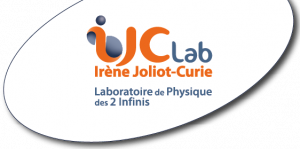
The Vera C. Rubin Observatory in Chile has just revealed its first images of the universe, marking the culmination of decades of research and development. Teams from IJCLab have contributed to the telescope's measurement reliability and data analysis.
This image combines 678 separate images taken by NSF–DOE Vera C. Rubin Observatory in just over seven hours of observing time. Combining many images in this way clearly reveals otherwise faint or invisible details, such as the clouds of gas and dust that comprise the Trifid nebula (top) and the Lagoon nebula, which are several thousand light-years away from Earth. Credit: NSF–DOE Vera C. Rubin Observatory
A major mission: mapping the universe in motion
The Vera C. Rubin Observatory's mission is to repeatedly observe the southern night sky over a decade, recording all visible sky every four days with unprecedented precision and depth. This survey will bring the night sky to life and pave the way for numerous discoveries in our nearby universe (asteroids, comets, pulsating stars, stellar explosions) as well as in the distant universe with the discovery of billions of new galaxies, thousands of supernovae, and the opportunity to study the largest structures in the Universe.
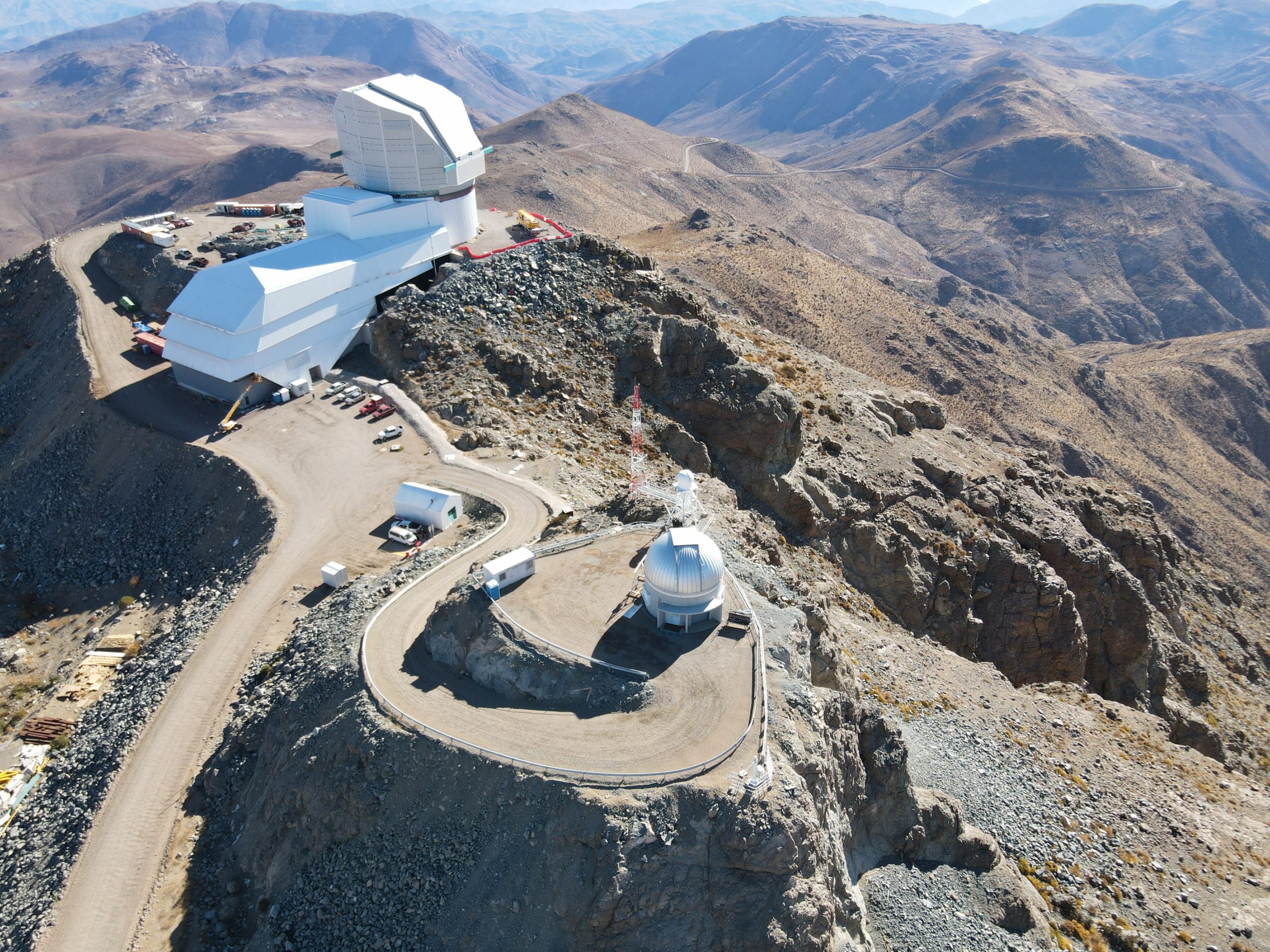
Drone photos of the Rubin Observatory summit facility (provided by Dome Surveyor, Oscar Rivera).
Each night, the telescope will collect 20 petabytes of data. In France, the CC-IN2P3 computing center in Lyon contributes to their storage and processing. This data will be made available to scientists worldwide, fostering discoveries and advances for decades to come. It will help us better understand the Universe, trace its evolution, and unlock the mysteries of dark energy and dark matter.
Holographic spectroscopy calibration: when laser meets astronomy
To achieve this cosmic mapping, the observatory's telescope benefits from technology developed at IJCLab: holographic spectroscopy. This technique measures atmospheric impact to compensate for its effects. It will achieve 0.1% precision in measuring stellar flux with the main telescope—at least twice better than current systems.
Why is this improvement in precision important? The atmosphere acts as a filter that alters light from stars and galaxies. It's therefore necessary to measure this absorption to correct the fluxes received by the telescope and reconstruct the fluxes as they arrive at the top of the atmosphere. For the Rubin Observatory, this task is performed by the auxiliary telescope. This telescope, equipped with a slitless spectrometer, will compare in real-time the ground-based spectra of standard stars with their spectra at the top of the atmosphere, known from space observatories like Hubble.
Holography, best known for its ability to render three-dimensional vision, has enabled combining the functions of light dispersion like a prism or ordinary periodic grating would and focusing into a single optical element, without which spectra couldn't be sharp across the entire color range.
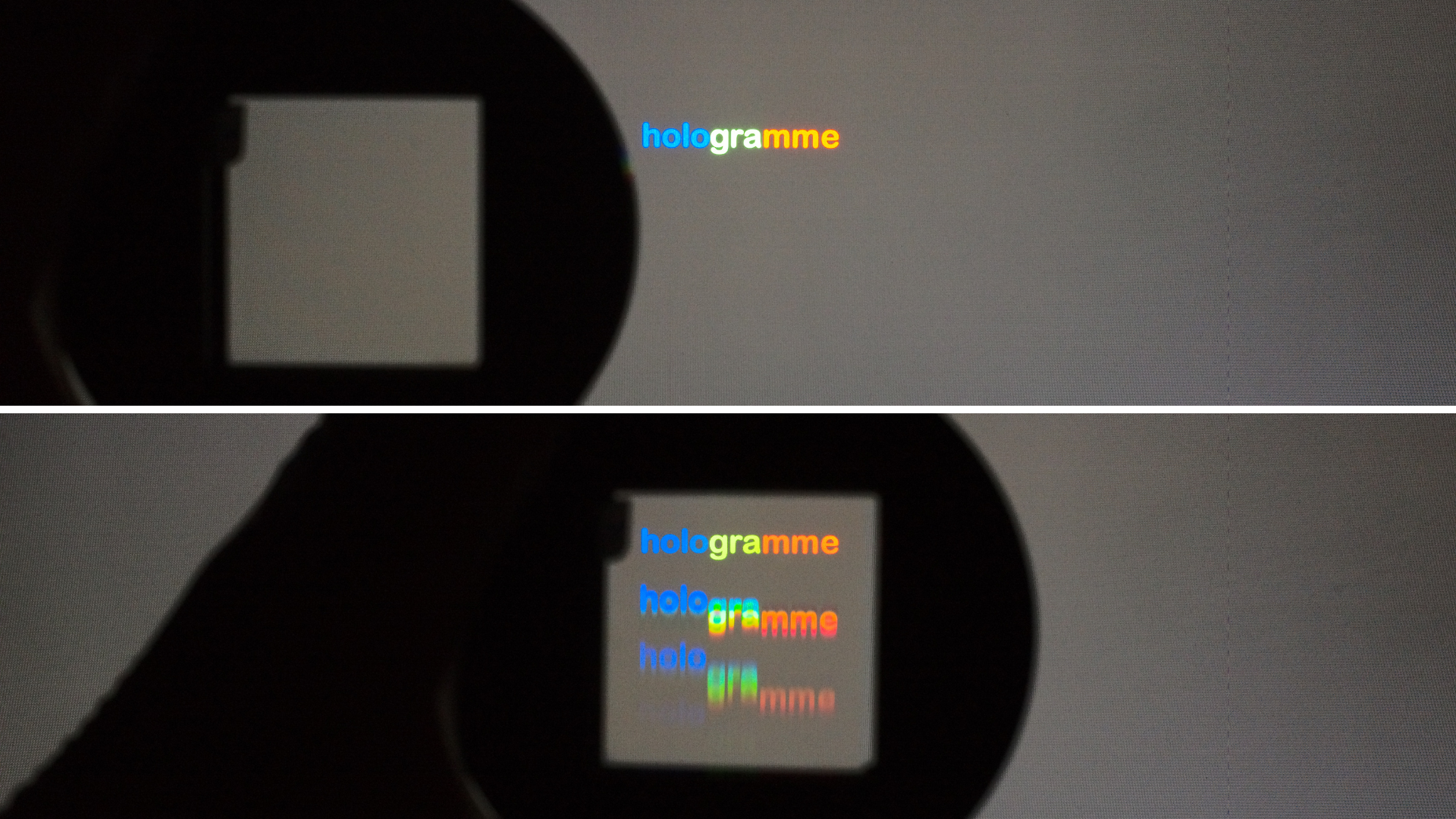
The hologram is a photographic plate that recorded the interference pattern of two waves from the same laser source. After development, a non-periodic network of lines appears. This grating, placed in the telescope's image beam, disperses and focuses the light. Credit : Marc Moniez (IJCLab).
This transformation of a telescope into a spectrograph through custom hologram fabrication represents a world first in astronomical instrumentation, positioning France at the forefront of this field.
The Collimated Beam Projector: an "artificial star" for calibrating the universe
IJCLab also contributes to the Vera C. Rubin Observatory's reliability through the Collimated Beam Projector (CBP), an instrument that acts as an "artificial star." This tool sends a monochromatic light beam whose flux and color are controlled to 0.1%, allowing measurement of the telescope and its filters' transmission.
"To do cosmology with Type Ia supernovae, we need to measure their luminosity and color with extreme accuracy," explains Enya Van Den Abeele from IJCLab's A2C-LSST team. "If the telescope's transmission is poorly known, it can bias our distance measurements and distort our understanding of dark energy."
A first version of the CBP is installed in the Vera C. Rubin Observatory dome and has performed its first telescope scans. Meanwhile, IJCLab has designed a portable version in collaboration with LPNHE, the Traveling CBP (TCBP), which can be transported to different sites.
This mobile approach has proven successful during two campaigns: the first on the StarDICE telescope at the Haute-Provence Observatory, the second on ZTF at Mount Palomar in California.
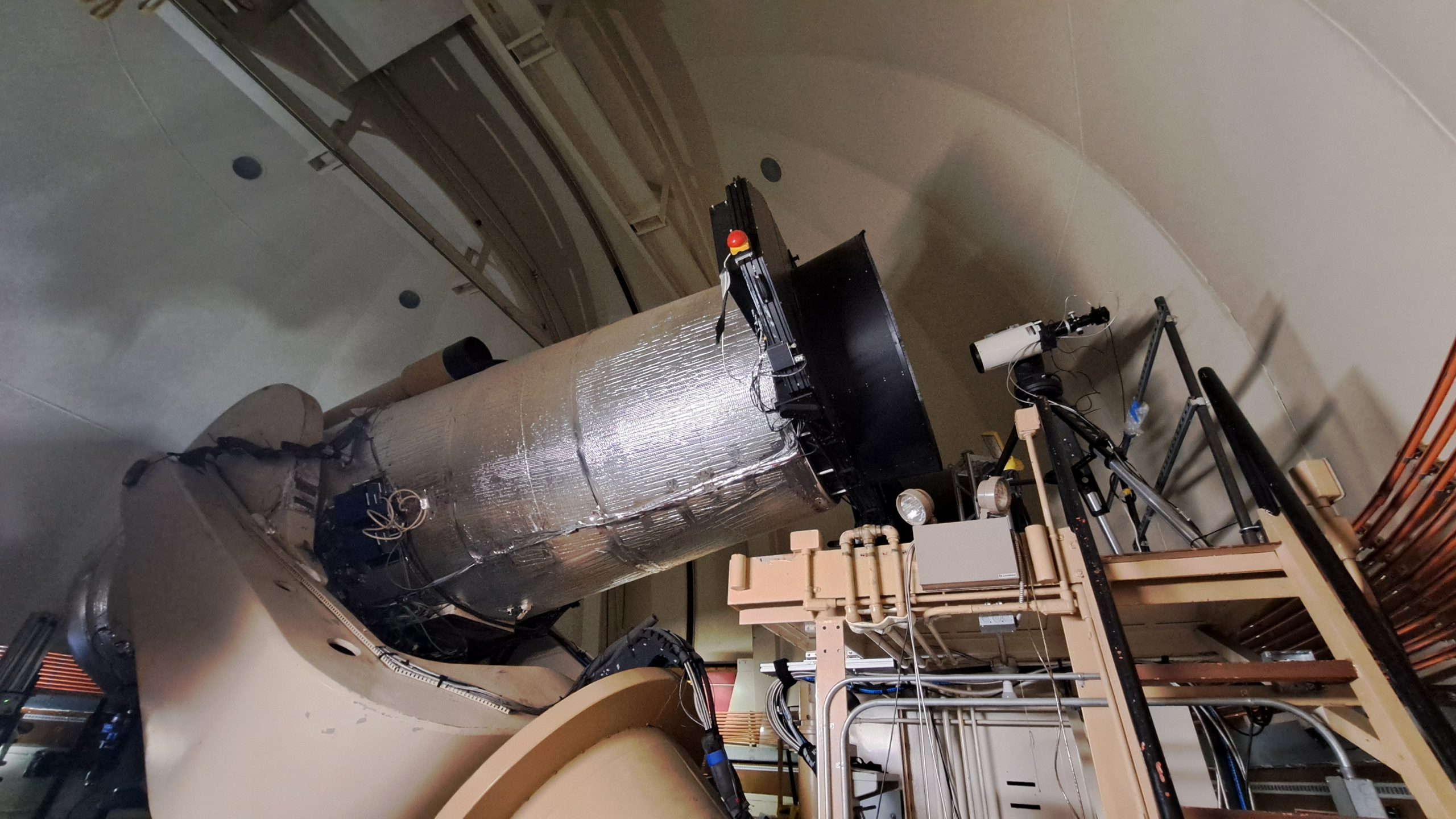
The traveling CBP at the Zwicky Transient Facility. Credit : Enya Van Den Abeele (IJCLab)
The next step will involve scanning the Vera C. Rubin Observatory's auxiliary telescope with the TCBP, ensuring that atmospheric transmission measurements aren't biased by the telescope's instrumental response.
FINK: artificial intelligence in service of discovery
Analyzing massive data volumes presents another major challenge. IJCLab has developed FINK, an automated alert system that will transform how Vera C. Rubin Observatory data is exploited. Each night, this telescope will generate approximately 10 million astronomical alerts over ten years: an unparalleled analysis challenge.
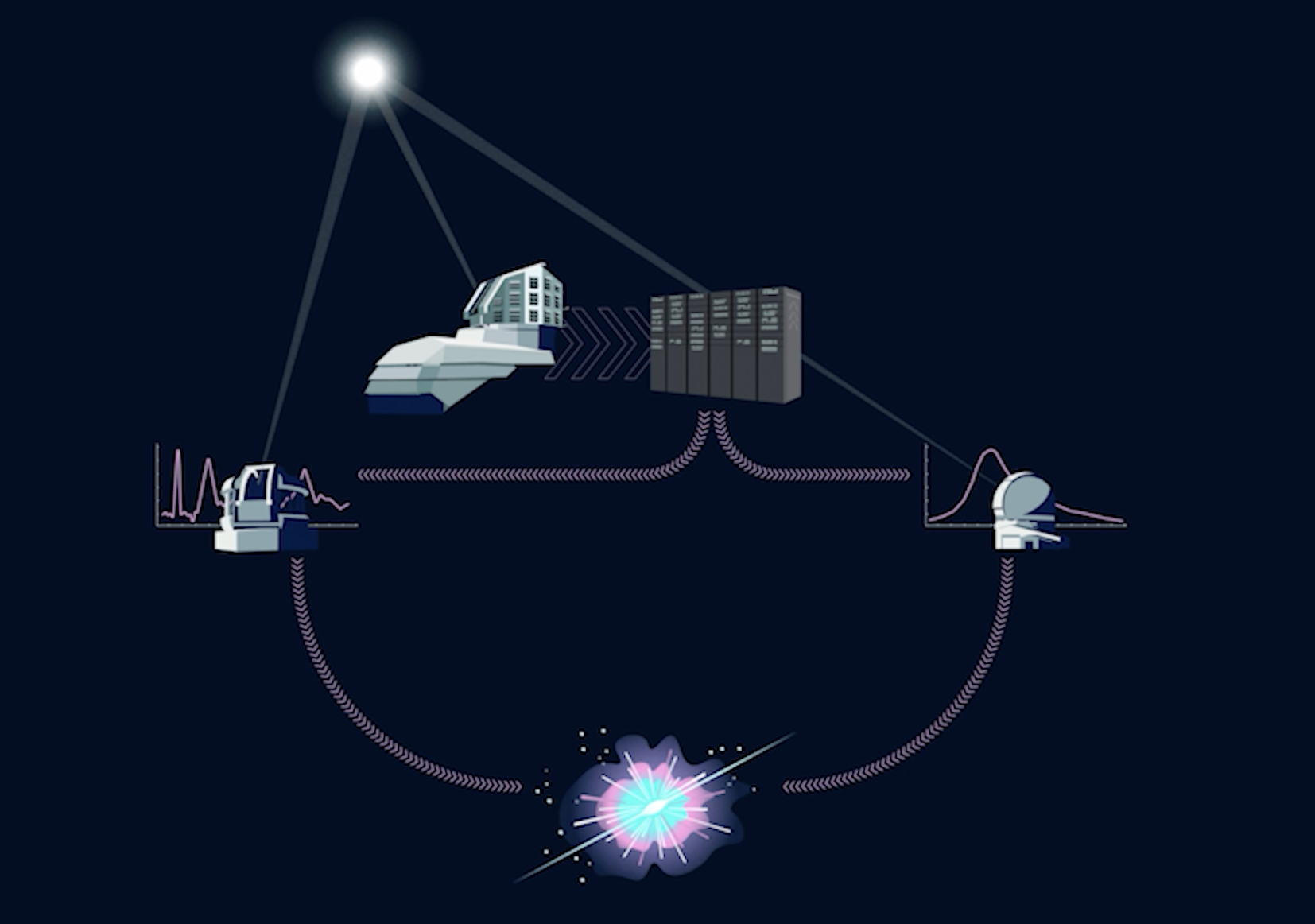
Illustration of FINK's data acquisition and transmission by Alice Carneau (CNRS Nuclear and Particles).
FINK, entirely designed and prototyped at IJCLab in the VirtualData cloud, relies on machine learning to identify the most interesting astronomical phenomena in real-time. The system must process 10,000 alerts every 30 seconds, enabling automatic detection of supernovae, asteroids, exoplanets, and other transient phenomena.
Since 2019, FINK has contributed to detecting over 1,000 Type Ia supernovae used for dark energy studies, discovered a new exoplanet located 3,000 light-years away, and helped identify new asteroids in our solar system.
An international collaboration coordinated from France
These projects mobilize a multidisciplinary IJCLab team comprising 6 researchers and 2 technician-engineers, covering fields ranging from high-tech optics to computational astrophysics. This French expertise integrates into the international scientific collaboration DESC (Dark Energy Science Collaboration), dedicated to understanding dark energy.
These first images from the Vera C. Rubin Observatory mark the beginning of a decade of exploration that could transform our understanding of the universe. Thanks to contributions from numerous CNRS Nuclear and Particle laboratories (IJCLab, IN2P3 Computing Center (CNRS/IN2P3-CC),Laboratory of Subatomic Physics and Cosmology (LPSC), Laboratory of Nuclear and High Energy Physics ( LPNHE - CNRS/IN2P3 - SU - UPCité), Institute of Physics of the 2 Infinities, Annecy Laboratory of Particle Physics (LAPP - CNRS/IN2P3 - USMB), Astroparticle and Cosmology Laboratory (APC), Particle Physics Centre of Marseille (CPPM), Universe and Particles Montpellier Laboratory (LUPM) and the Caen Corpuscular Physics Laboratory (LPC), astronomers will have tools of unprecedented accuracy to:
- Characterize dark energy, this mysterious force accelerating the universe's expansion
- Map dark matter with unequaled resolution
- Automatically detect rare or unexpected astronomical phenomena
- Measure cosmic acceleration variations to test theoretical models
"If we measure light fluxes to 0.1% precision, we can constrain dark energy parameters to better than 1%" emphasizes Jérémy Neveu from the laboratory's A2C-LSST team. "This will allow us to refine our understanding of this unknown entity and distinguish between different theoretical models."
These French technological advances, integrated at the heart of the Vera C. Rubin Observatory, pave the way for a new era of cosmological discoveries, where instrumental precision enables exploration of the universe's deepest mysteries.
The Vera C. Rubin Observatory, formerly known as the Large Synoptic Survey Telescope (LSST), is located on Cerro Pachón in Chile. This $1.2 billion project will survey the entire southern sky for ten years, producing the largest movie of the universe ever made.
